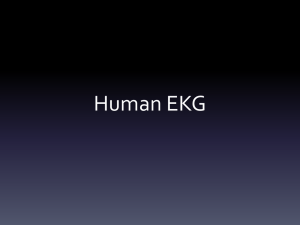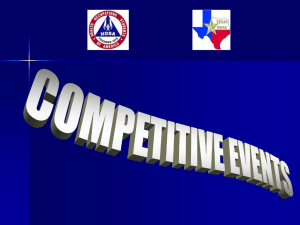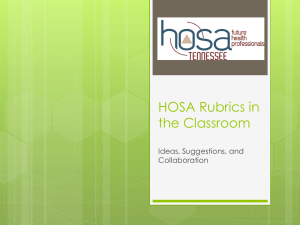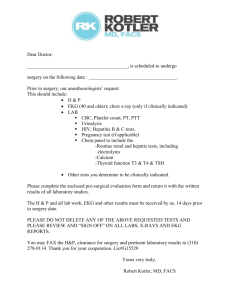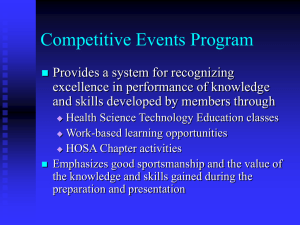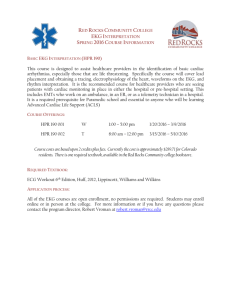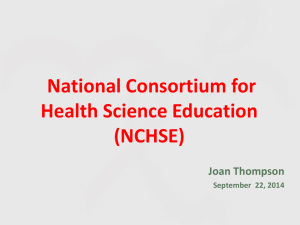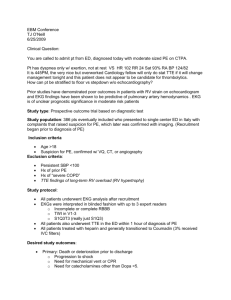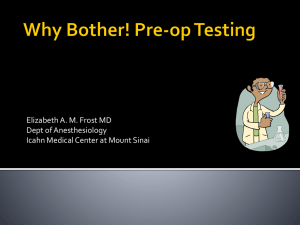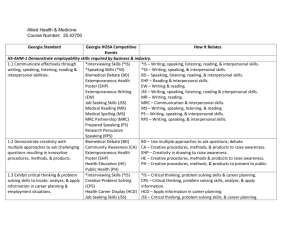Non-Invasive Diagnostic Technology
advertisement
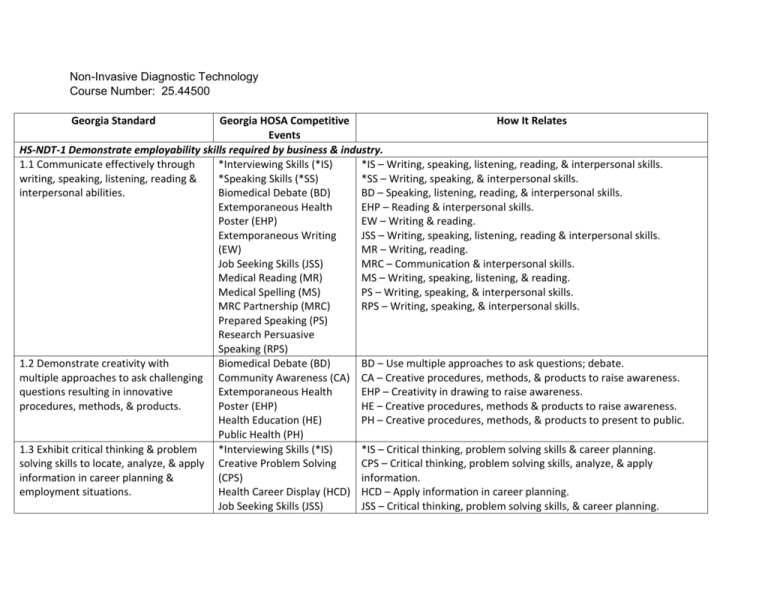
Non-Invasive Diagnostic Technology Course Number: 25.44500 Georgia Standard Georgia HOSA Competitive How It Relates Events HS-NDT-1 Demonstrate employability skills required by business & industry. 1.1 Communicate effectively through *Interviewing Skills (*IS) *IS – Writing, speaking, listening, reading, & interpersonal skills. writing, speaking, listening, reading & *Speaking Skills (*SS) *SS – Writing, speaking, & interpersonal skills. interpersonal abilities. Biomedical Debate (BD) BD – Speaking, listening, reading, & interpersonal skills. Extemporaneous Health EHP – Reading & interpersonal skills. Poster (EHP) EW – Writing & reading. Extemporaneous Writing JSS – Writing, speaking, listening, reading & interpersonal skills. (EW) MR – Writing, reading. Job Seeking Skills (JSS) MRC – Communication & interpersonal skills. Medical Reading (MR) MS – Writing, speaking, listening, & reading. Medical Spelling (MS) PS – Writing, speaking, & interpersonal skills. MRC Partnership (MRC) RPS – Writing, speaking, & interpersonal skills. Prepared Speaking (PS) Research Persuasive Speaking (RPS) 1.2 Demonstrate creativity with Biomedical Debate (BD) BD – Use multiple approaches to ask questions; debate. multiple approaches to ask challenging Community Awareness (CA) CA – Creative procedures, methods, & products to raise awareness. questions resulting in innovative Extemporaneous Health EHP – Creativity in drawing to raise awareness. procedures, methods, & products. Poster (EHP) HE – Creative procedures, methods & products to raise awareness. Health Education (HE) PH – Creative procedures, methods, & products to present to public. Public Health (PH) 1.3 Exhibit critical thinking & problem *Interviewing Skills (*IS) *IS – Critical thinking, problem solving skills & career planning. solving skills to locate, analyze, & apply Creative Problem Solving CPS – Critical thinking, problem solving skills, analyze, & apply information in career planning & (CPS) information. employment situations. Health Career Display (HCD) HCD – Apply information in career planning. Job Seeking Skills (JSS) JSS – Critical thinking, problem solving skills, & career planning. MRC Partnership (MRC) 1.4 Model work readiness traits required for success in the workplace including integrity, honesty, accountability, punctuality, time management, & respect for diversity. 1.5 Apply the appropriate skill sets to be productive in a changing, technological, & diverse workplace to be able to work independently, interpret data, & apply teamwork skills. *Interviewing Skills (*IS) *Speaking Skills (*SS) Conference Dress Code Job Seeking Skills (JSS) Prepared Speaking (PS) Researched Persuasive Speaking (RPS) Biomedical Debate (BD) Community Awareness (CA) Creative Problem Solving (CPS) Forensic Medicine (FM) Health Career Display (HCD) Health Education (HE) HOSA Bowl (HB) Knowledge Test: Transcultural Health Care (KT-THC) Medical Innovation (MI) Parliamentary Procedures (PP) Public Service Announcement (PSA) All Competitive Events Conference Dress Code MRC – Critical thinking, problem solving skills, apply information for career planning, & employment situations. *IS – Model work readiness traits. *SS – Model work readiness traits. Conference dress code models work readiness traits. JSS – Model work readiness traits. PS – Model work readiness traits. RPS – Model work readiness traits. BD – Diversity, interpret data, & apply teamwork. CA – Diversity, interpret data, & apply teamwork. CPS – Interpret data & apply teamwork. FM – Interpret data & apply teamwork. HCD – Interpret data & apply teamwork. HE – Diversity, apply teamwork. HB – Interpret data & apply teamwork. KT-THC – Diversity within workplace. MI – Technological environment, interpret data, & apply teamwork. PP – Interpret data & apply teamwork. PSA – Technological environment & apply teamwork. 1.6 Present a professional image Dress code requires students to be in a navy blue or black suit at all through appearance, behavior, & times. language. HS-NDT-2 Demonstrate a professional demeanor at all times, both in the classroom and within the healthcare facilities. 2.1 Demonstrate dependability as it All Competitive Events All competitive events require the student to be present, on time & relates to being present, on time, and ready to participate. ready to participate. 2.2 Show compassion as it relates to All Competitive Events Student work ethics. being sensitive to the needs of patients and coworkers. 2.3 Exhibit flexibility as it relates to All Competitive Events Students participating in Competitive Events accept the added their willingness to adapt to changes, responsibility of preparing for their event. There are 15 events that accept added responsibility, and be a require the student to be a team player. team player 2.4 Perform honesty as it relates to All Competitive Events Students participating in Competitive Events will experience work ethics willingness to admit mistakes, to get that pertain to honesty and acceptance of criticism. help when unsure of a procedure, and to act in the interest of client safety. 2.5 Demonstrate integrity as it relates All Competitive Events Student work ethics. to client privacy and client confidentiality. 2.6 Exhibit proper personal appearance All Competitive Events Students are required to be in professional dress code. to include appropriate dress code, good personal hygiene, and professional demeanor. 2.7 Display the importance of good All Competitive Events Students work ethics. organizational skills and time management skills including completion of assignments. HS-NDT-3 Investigate professional ethics and legal responsibilities relating to non-invasive testing in the area of radiology, cardiology and pulmonary. 3.1 Maintain confidentiality and privacy HOSA Bowl (HB) HB – Round 2 questions to include HIPAA regulations Knowledge Test: Medical L&E – Testing Law & Ethics (L&E) 3.2 Explain medico legal concepts as it relates to different non-invasive careers. 3.3 Demonstrate adhering to and understanding the personal and professional code of ethics. 3.4 Investigate the national professional standards related to Radiology Technologists, EKG Technicians, and Respiratory Therapists, including careers available in each field. 3.5 Evaluate how culture and diversity affects the delivery of care. Knowledge Test: Medical Law & Ethics (L&E) L&E – Testing HOSA Bowl (HB) Knowledge Test: Medical Law & Ethics (L&E) Health Career Display (HCD) HOSA Bowl (HB) Knowledge Test: Medical Law & Ethics (L&E) HB – Round 2 questions L&E – Testing Knowledge Test: Human Growth & Development (HGD) Knowledge Test: Medical Law & Ethics (L&E) Knowledge Test: Transcultural Healthcare (Trans) HOSA Bowl (HB) Knowledge Test: Medical Law & Ethics (L&E) HGD – Testing L&E – Testing Trans – Testing 3.6 Examine scope of practice, torts, malpractice, negligence, invasion of privacy, privileged communication, confidentiality and informed consent as it relates to career in noninvasive diagnostic testing. 3.7 Discuss and understand the HOSA Bowl (HB) patient’s rights to Informed Consent, Knowledge Test: Medical Advance Directives, Do Not Resuscitate Law & Ethics (L&E) (DNR) orders), and a Living Will. HS-NDT-4 Differentiate the services provided in diagnostic imaging. HCD – Career exploration HB – Round 2 questions L&E – Testing HB – Round 2 questions L&E – Testing HB – Round 2 questions L&E – Testing 4.1 Differentiate between the types of Health Career Display (HCD) HCD – Career Exploration diagnostic imaging and the types of HOSA Bowl (HB) HB – Round 2 questions medical information each generates, Medical Assisting (MA) MA – Testing including but not limited to Computer Assisted Tomography (CAT), Magnetic Resonance Imaging (MRI), Positron emissions Tomography (PET), Ultrasound Imaging, Mammography and X-Rays. 4.2 Differentiate how the types of Health Career Display (HCD) HCD – Career Exploration diagnostic imaging might be utilized for HOSA Bowl (HB) HB – Round 2 questions diagnosis, treatment, and monitoring Medical Assisting (MA) MA – Testing of a medical condition. HS-NDT-5 Demonstrate proper safety principles relating to Radiology, EKG and Respiratory Technicians. 5.1 Demonstrate adhering to radiation protection for patient and personnel, including basic methods of protection: time, distance and shielding. 5.2 Distinguish between the protective devices (engineering controls) and procedures (work practice controls) available to provide proper patient care, including when and how to use the devices 5.3 Demonstrate utilizing radiationsafety principles and guidelines, including ALARA (as low as (is) reasonably achievable) principles and PMD (Personal Monitoring Devices). 5.4 Research the importance of HOSA Bowl (HB) HB – Round 2 questions governing agencies and roles, including L&E – Testing FDA (Food and Drug Administration, Knowledge Test: Medical Pharm – Testing OSHA (Occupational Safety and Health Law & Ethics (L&E) Administration), MQSA (Mammography Knowledge Test: Quality Standards Act), ACR (American Pharmacology (Pharm) College of Radiology), and the NRC (Nuclear Radiation Commission). 5.5 Apply proper body mechanics for *Personal Care (*PC) *PC – Procedures I, II, III, IV & V the safety of the healthcare worker and Home Health Aide (HHA) HHA – Testing & Procedure VII patients when performing simulated Nursing Assisting (NA) NA – Testing & Procedures I, II, III, IV, V, VI, VII & VIII procedures. 5.6 Apply the appropriate infection *Personal Care (*PC) *PC – Procedures I, II, III, IV & V control standards while performing Home Health Aide (HHA) HHA – Testing & Procedure VII procedures in radiology, cardiology or Nursing Assisting (NA) NA – Testing & Procedures I, II, III, IV, V, VI, VII & VII pulmonary services. HS-NDT-6 Demonstrate an understanding of image acquisition and evaluation 6.1 Differentiate between film screen processing and digital imaging processing. 6.2 Explain the importance of image Knowledge Test: Medical L&E – Testing identification in diagnostic imaging and Law & Ethics (L&E) understand the legal considerations (patient data, examination data) if not performed properly. 6.3 Identify image quality related to HOSA Bowl (HB) HB – Round 2 questions film brightness/density, contrast/gray scale, motion, artifacts, fog, required anatomy, and positioning accuracy. 6.4 Investigate the PACS (picture archiving and communication system) system related to diagnostic imaging. 6.5 Recognize currently-utilized diagnostic imaging equipment. HS-NDT-7 Electrocardiogram (EKG) Demonstrate how to properly place leads and operate a 12-lead EKG (electrocardiogram) unit. 7.1 Demonstrate collecting and Medical Assisting (MA) MA – Procedures II & III documenting patient history, cardiac medication, and information needed for EKG testing. 7.1 Demonstrate setting up and verifying the leads recorded on an EKG. 7.2 Demonstrate verifying EKG machine paper speed (e.g., 25mm, 50mm) and EKG machine sensitivity (e.g., h, 1, 2). 7.3 Inspect the waveforms of a cardiac cycle for symmetry, direction, and amplitude (e.g., P waves, QRS complexes, ST segments, and T waves). 7.4 Demonstrate troubleshooting a 12lead EKG unit. 7.5 Demonstrate mounting a completed EKG for a patient’s chart and properly uploading a completed EKG to a patient’s electronic medical record. 7.6 Demonstrate how to maintain EKG equipment and the work environment. 7.7 Demonstrate correctly positioning a patient for testing and applying EKG leads in the correct position on the patient. 7.8 Apply electrodes on patient and understand how to respond to signs and symptoms of cardiopulmonary compromise. 7.9 Demonstrate performing patient *Personal Care (*PC) *PC – Procedure V vital signs (heart rate, respirations, Clinical Nursing (CN) CN – Procedure III temperature, blood pressure) and Home Health Aide (HHA) HHA – Procedures I & II utilizing a pulse oximeter) to monitor Nursing Assisting (NA) NA – Procedure VI patient during procedures. 7.10 Demonstrate informing patients Clinical Specialty (CS) CS about the purpose of procedure and Medical Assisting (MA) MA – Testing directions for testing, including EKG (Electrocardiogram) monitoring, Holter monitoring, Stress testing, and Telemetry monitoring 7.11 Differentiate between the care Clinical Nursing (CN) CN – Testing needed for infant, pediatric, adult Home Health Aide (HHA) HHA – Testing patients and those with special Nursing Assisting (NA) NA – Testing considerations (e.g., right sided heart, posterior chest, amputations). HS-NDT-8 Demonstrate and explain how EKG grid paper is used, and plot EKG axis. 8.1 Calculate a patient’s heart rate from the EKG tracing (e.g., 6-second method, R to R, sequencing). 8.2 Measure a patient’s heart rhythm from the EKG tracing. 8.3 Measure a patient’s heart conduction from the EKG tracing (e.g., PR-interval, QRS duration and QTinterval). HS-NDT-9 Recognize normal and abnormal patterns in all EKG leads and understand proper procedures that medical professionals utilize in responding to and reporting results. 9.1 Identify and resolve artifacts from the EKG tracing (e.g., wandering baseline, somatic, and electrical). 9.2 Identify and determine how a medical professional evaluates sinus rhythm and major classifications of arrhythmias from the EKG tracing (sinus, atrial, ventricular, junctional, and heart blocks). 9.3 Describe and demonstrate response *Life Support Skills (*LSS) *LSS – Procedure I to potentially life-threatening CPR/First Aid (CPR) CPR – Testing & Procedures VI, VII, VIII & IX arrhythmias. Emergency Medical EMT – Testing & Procedure VI Technician (EMT) 9.4 Recognize pacemaker spikes on an EKG tracing. 9.5 Identify the major variances to waveforms related to ischemia, injury, or infarction. HS-NDT-10 Apply patient assessment techniques to differentiate the need for non-invasive pulmonary diagnostic testing. 10.1 Identify and describe basic Medical Terminology (MT) MT – Testing cardiopulmonary anatomy and medical terminology for the cardiopulmonary system. 10.2 Demonstrate utilizing assessment *Personal Care (*PC) *PC – Procedure V skills to check vital signs, height and Home Health Aide (HHA) HHA – Testing & Procedures I & II weight, initial impressions of patient, Medical Assisting (MA) MA – Testing & Procedures III & IV and record patient history Nursing Assisting (NA) NA – Testing & Procedure VI 10.3 Apply examinations techniques, CPR/First Aid (CPR) CPR – Testing including visual examination head to Emergency Medical EMT – Testing & Procedures I & II extremities (chest appearance, Technician (EMT) clubbing, cyanosis, pedal edema, capillary refill, and skin temperature), auscultation of lung and heart sounds, palpitation, and percussion. 10.4 Differentiate between normal and *Personal Care (*PC) *PC – Procedure V abnormal breath sounds. Nursing Assisting (NA) NA – Testing & Procedure VI 10.5 Recognize various breathing *Personal Care (*PC) *PC – Procedure V patterns and respiratory effort. Nursing Assisting (NA) NA – Testing & Procedure VI 10.6 Demonstrate utilizing pulse Clinical Nursing (CN) CN – Procedure III oximetry as a tool for assessing patient basic oxygen needs and differentiate between normal and abnormal readings. 10.7 Observe a medical professional utilizing chest radiography to recognize normal and abnormal chest findings and apply a systematic approach to reading the chest radiography as an important diagnostic tool. HS-NDT-11 Differentiate between the types and the need for pulmonary non-invasive diagnostic testing. (Simulation in the lab or observations in a clinical setting) 11.1 Describe the basic types of pulmonary non-invasive diagnostic testing (chest X-ray, peak flow meters, basic pulmonary function test (spirometry). 11.2 Identify and describe the lung volumes and capacities of the averaged size adult. 11.3 Differentiate between the use of peak flow meters and basic pulmonary function testing (simple spirometry). 11.4 Observe a medical professional teaching proper peak flow technique, performing a peak flow test, and appropriately interpreting information 11.5 Properly calibrate and set up spirometer and discuss the limitations of basic spirometry and the need for more advance pulmonary function testing. Observe as a medical professional interprets basic spirometer results. 11.6 Apply principles of infection control to prevent cross contamination of patients when using simple pulmonary function testing. 11.7 Differentiate between restrictive and obstructive pulmonary disease based on the expected pulmonary functions results. 11.8 Discuss contraindications to pulmonary diagnostic testing. HS-NDT-12 Research careers and certification available in careers that utilize non-invasive diagnostic techniques in fields of radiology, cardiology and pulmonary. 12.1 Research career opportunities in Health Career Display (HCD) HCD – Career exploration fields that utilize non-invasive HOSA Bowl (HB) HB – Round 2 questions diagnostic techniques in radiology/imaging, cardiology and pulmonary. 12.2 Investigate certifications and Health Career Display (HCD) HCD – Career exploration further education available for HOSA Bowl (HB) HB – Round 2 questions proficiency in using noninvasive diagnostic testing 12.3 Analyze the trends and advantages in the hiring multi-skilled medical workers. Health Career Display (HCD) Healthcare Issues Exam (HIE) HOSA Bowl (HB) HS-NDT-13 Complete a CPR Basic Life Support and first aid course. 13.1 Successfully complete Basic Life *Life Support Skills (*LSS) Support CPR course by a recognized CPR/First Aid (CPR) agency, such as the American Heart Emergency Medical Association or American Red Cross. Technician (EMT) 13.2 Successfully complete a First Aid *Life Support Skills (*LSS) course by a recognized agency, such as CPR/First Aid (CPR) the American Heart Association or Emergency Medical American Red Cross. Technician (EMT) HCD – Career exploration HIE – Analyzing trends in healthcare HB – Round 2 questions *LSS – Procedures I, II, III & IV CPR – Testing & Procedures I, II, III, IV, V, VI, VII, VIII & IX EMT – Testing & Procedures I, II, III, IV, V & VI *LSS – Procedures I, II, III & IV CPR – Testing & Procedures I, II, III, IV, V, VI, VII, VIII & IX EMT – Testing & Procedures I, II, III, IV, V & VI
